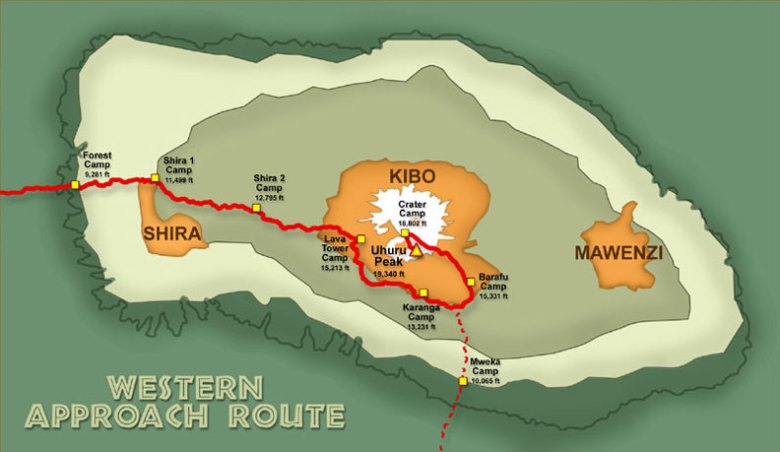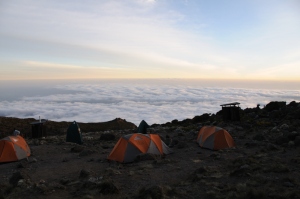In June and July of 2009, John Holt, co-founder and CEO of The Cobalt Group and his fourteen year-old daughter Gemma climbed Mt. Kilimanjaro. Kilimanjaro is a dormant stratovolcano in north-eastern Tanzania rising 15,100 feet from its base and approximately 16,700 feet from the plains near Moshi. It is the highest peak in Africa at 19,340 feet, providing dramatic views of Tanzania and southern Kenya.
Can you give us an overview of the route you and Gemma took?
 John Holt: Western Approach Route (9 Days)
John Holt: Western Approach Route (9 Days)
Day 1 – Londorosi Gate to Forest Camp: 3-4 Hrs. to 9,261 Feet
Day 2 – Forest Camp to Shira 1 Camp: 5-6 Hrs. to 11,439 Feet
Day 3 – Shira 1 Camp to Shira 2 Camp: 3-4 Hrs. to 12,795 Feet
Day 4 – Shira 2 Camp to Lava Tower Camp: 4-6 Hrs. to 15,213 Feet
Day 5 – Lava Tower Camp to Karanga Camp: 6-7 Hrs. to 13,340 Feet
Day 6 – Karanga Camp to Barafu Camp: 5-6 Hrs. to 15,331
Day 7 – Barafu Camp to Crater Camp: 8-10 Hrs. to 18,802 and 1-2 Hrs. to the Summit at 19,340 Feet
Day 8 – Descent to Mweka Camp: 5-7 Hrs. to 10,065 Feet
Day 9 – Mweka Camp to Mweka Gate: 2-3 Hrs. to 6,000 Feet
What were some of the challenges of days four to six?
 John Holt:Acclimatization is essential, and most people suffer some degree of altitude sickness. About 10 Kili climbers die from this each year, together with a number of local porters – figures for these are guessed at between 10-20. We saw the first memorial to someone who died taking this journey on our day four climb, and it was a reminder of to us of how serious the altitude issues can be. Kilimanjaro’s summit is well above the altitude at which high altitude pulmonary edema or high altitude cerebral edema can occur. Any climber can suffer considerable discomfort, typically shortage of breath, hypothermia and/or headaches.
John Holt:Acclimatization is essential, and most people suffer some degree of altitude sickness. About 10 Kili climbers die from this each year, together with a number of local porters – figures for these are guessed at between 10-20. We saw the first memorial to someone who died taking this journey on our day four climb, and it was a reminder of to us of how serious the altitude issues can be. Kilimanjaro’s summit is well above the altitude at which high altitude pulmonary edema or high altitude cerebral edema can occur. Any climber can suffer considerable discomfort, typically shortage of breath, hypothermia and/or headaches.
It was very warm and bright during the days and cold at night. The terrain became more and more like a moonscape with no plants or animals, just lots of lava rocks and dust. At night the stars were so bright I needed no light at all to move about camp. We were far from civilization and ambient light; it was magnificent. When we reached Lava Tower camp at 15,213 feet, we had sufficient strength to climb the vertical rock face; Gemma and I enjoyed the challenge and some magnificent views together. We both had experienced brief waves of nausea, and we decided it was time for Gemma to start taking Diamox, otherwise known as acetazolamide, to help her cope with the various effects of altitude sickness. I had read that younger people often have a tougher time with altitude. I was now higher than I’d ever been and I wanted to wait and see how my body would adjust without medication.
 That night I woke at 1am and thought my brain was going to explode; I could hear every pulse in what felt like a big artery in my head! Since I didn’t know what would happen next, and I didn’t want to cost Gemma a chance at the summit, I decided to end my human biology experiment; I started taking Diamox. Day five took us lower to Karanga Camp at 13,340 feet; I knew I would feel better as soon as we started to descend and did. Hiking up a narrow trail with enormous cliffs on one side (and porters passing you from time to time), we had to use our hands and feet to climb up the Barranco Wall. Most of it is manageable but there are a few spots that are quite vertical and steep. Gemma was having a tough time on this leg of the hike. Against her protests I offered to carry her pack and mine. I told her we were engaged in a ‘team sport’ and she needed to focus on getting strong for the summit. It was just three months since she tore the medial collateral ligament in her left knee and she’d been in a brace until the middle of May. I was already so proud of her; there weren’t many younger kids on the mountain.
That night I woke at 1am and thought my brain was going to explode; I could hear every pulse in what felt like a big artery in my head! Since I didn’t know what would happen next, and I didn’t want to cost Gemma a chance at the summit, I decided to end my human biology experiment; I started taking Diamox. Day five took us lower to Karanga Camp at 13,340 feet; I knew I would feel better as soon as we started to descend and did. Hiking up a narrow trail with enormous cliffs on one side (and porters passing you from time to time), we had to use our hands and feet to climb up the Barranco Wall. Most of it is manageable but there are a few spots that are quite vertical and steep. Gemma was having a tough time on this leg of the hike. Against her protests I offered to carry her pack and mine. I told her we were engaged in a ‘team sport’ and she needed to focus on getting strong for the summit. It was just three months since she tore the medial collateral ligament in her left knee and she’d been in a brace until the middle of May. I was already so proud of her; there weren’t many younger kids on the mountain.
Later that day after we arrived in camp we had a funny moment. I felt really strong and took a walk to get a look at our surroundings. As I returned to camp I was was alerted that Gemma was having a nose bleed. As I approached I stopped, pulled out my camera and started snapping pictures of her and her nose bleed, blood trickling down her face and all over her hands. Gemma called out, “Hey, aren’t you going to come help me?” I said, “I need to take pictures first, I am creating a documentary of our trip!” We had a good laugh over this.
 Our climb to Barafu Camp, where we would stay the night before our summit attempt, took us back up to 15,300 feet. I felt really good, probably from a combination of the Diamox and continued acclimatization. We were going to summit one night before the full moon, a good omen we hoped. At Barafu we met people descending who had not made the summit. One young man had to have a shot of cortisone because his legs had stopped working. The young German woman climbing with him looked really rung out and said it was the hardest thing she had ever done. Hearing stories like this caused some anxiety in our group, but there wasn’t much to do except get some sleep.
Our climb to Barafu Camp, where we would stay the night before our summit attempt, took us back up to 15,300 feet. I felt really good, probably from a combination of the Diamox and continued acclimatization. We were going to summit one night before the full moon, a good omen we hoped. At Barafu we met people descending who had not made the summit. One young man had to have a shot of cortisone because his legs had stopped working. The young German woman climbing with him looked really rung out and said it was the hardest thing she had ever done. Hearing stories like this caused some anxiety in our group, but there wasn’t much to do except get some sleep.
I had no doubt about our physical ability, Gemma and I were in great shape and we had the energy and stamina to make the climb. But condition doesn’t have much of anything to do with how your body reacts to altitude, so at no point in time did we feel over-confident about making it to the summit. We knew plenty of people who’d made it, but I also knew quite a few who’d had to turn back.
Our campsite that last night was so steep that our sleeping bags kept sliding towards the downhill edge of our tent. It was also bitterly cold. Plus we knew we had to get up at 4:30 am to begin the 4,000 foot climb to the summit. It would be the steepest day of our climb, and it was also all new altitude. Every step took us higher than we’d ever been before.
Part Three and the Kilimanjaro Summit attempt coming soon…
The Cobalt Group
www.cobalt.com
www.twitter.com/CobaltMarketing
www.youtube.com/cobaltlive
![]()
October 7, 2009 at 8:39 PM
[…] Go Here to read Part One Go here to read Part Two […]